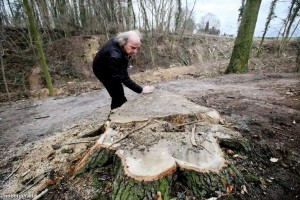It is by no way restricted to Limburg, it happens all over the country: perfectly well developed trees are cut down in forests, avenues and woodland gardens because… the species involved are not ‘local’. In this particular case many specimens of what we call Amerikaanse eik (American Oak, or Quercus rubra), are removed from the slopes of the ‘Wijngaardsberg‘ in Huis Vliek‘s woodland garden.

According to a local newspaper article, the trees are around a century old and cut down because the current view is that in a wooded area like this, only ‘ecologically correct’ trees are wanted. If that is true, stupidity has reached new levels.
And it is partly true, as the local IVN group states in its newsletter of December 2011 that ecological reasons are the main driver of this action. Besides that, they claim safety reasons, as a lot of the older trees apparently are in a bad state – which is to be expected when architectural garden and park elements are treated as ‘nature’ over a period of 4 decades. Architecture needs maintenance, not neglect or a watch-what-happens-when-we-do-nothing approach. This whole action simply seems to be the result of ignorance, nurtured over a prolonged period of time.
Architecture?
The description of the gardens in the register of monuments state that many trees in this monumental garden (nr 470141) date from this period. 1The link leads to a somewhat more extensive description on ‘Rijksmonumenten.nl’, which is not related to the official governing body concerning monuments in The Neherlands: RCE. Part of the axis belonging to the 18th century garden was elongated towards the top of the Wijngaardsberg around 1900, and was then loosely planted with Quercus rubra. The register specifically states that there was no actual avenue planted in this section.
So not only is ‘ethnic cleansing’-to use a rather big word for once- possibly performed under the cover of ‘ecological maintenance’ (definately as a result of such maintenance), it is also quite possible that a deliberate landscape design from a century ago -prolonging an axis that itself was over a century old at the time, using plants that were ‘en vogue’ in the early 20th century- is demolished. A landscape design that may be attributed to Dirk Tersteeg (1907) or, after simplifying the design, to Leonard Springer (1915). 2But the Springer design seems to be limited to the garden around the house.
The worst thing seems to be that the Rijksdienst voor het Cultureel Erfgoed, the governing body that keeps an eye on these things, has been informed and apparently approved of the plans. I would like to see their motivation published somewhere, just to see what their considerations were.
At least all necessary parties have been asked for an opinion, it should be said…
And just as a pointer for future actions (and because it is a source I did not know of yet): here’s a nice view at monumental trees in the garden of Vliek.


